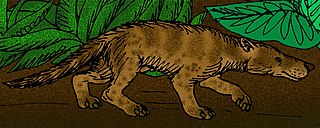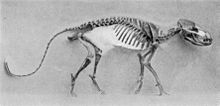
The jaw is any opposable articulated structure at the entrance of the mouth, typically used for grasping and manipulating food. The term jaws is also broadly applied to the whole of the structures constituting the vault of the mouth and serving to open and close it and is part of the body plan of humans and most animals.

Moose Jaw is the fourth largest city in Saskatchewan, Canada. Lying on the Moose Jaw River in the south-central part of the province, it is situated on the Trans-Canada Highway, 77 km (48 mi) west of Regina. Residents of Moose Jaw are known as Moose Javians. The city is surrounded by the Rural Municipality of Moose Jaw No. 161.

Ambulocetus is a genus of early amphibious cetacean from the Kuldana Formation in Pakistan, roughly 48 or 47 million years ago during the Early Eocene (Lutetian). It contains one species, Ambulocetus natans. Ambulocetus is known primarily from a single skeleton which is about 80% complete, and is among the most completely known Eocene cetaceans, instrumental in the study of cetacean evolution and the transition from land to sea. It had four functional limbs, and was the first cetacean discovered preserving a suite of adaptations consistent with an amphibious lifestyle. Ambulocetus is classified in the group Archaeoceti—the ancient forerunners of modern cetaceans whose members span the transition from land to sea—and in the family Ambulocetidae, which includes Himalayacetus and Gandakasia.

Andrewsarchus is an extinct genus of mammal that lived during the middle Eocene epoch in what is now Inner Mongolia, China. Only one species is usually recognized, A. mongoliensis, known from a single skull of great size discovered in 1923 during the expeditions to central Asia by the American Museum of Natural History (AMNH). Generally classified as a mesonychid since its original description, most recent studies classify it as an artiodactyl. One study specifically classifies Andrewsarchus as a member of the clade Cetancodontamorpha, closely related to entelodonts, hippos and cetaceans.

In terrestrial vertebrates, digitigrade locomotion is walking or running on the toes. A digitigrade animal is one that stands or walks with its toes (metatarsals) touching the ground, and the rest of its foot lifted. Digitigrades include walking birds, cats, dogs, and many other mammals, but not plantigrades or unguligrades. Digitigrades generally move more quickly and quietly than other animals.

Mesonychia is an extinct taxon of small- to large-sized carnivorous ungulates related to artiodactyls. Mesonychids first appeared in the early Paleocene, went into a sharp decline at the end of the Eocene, and died out entirely when the last genus, Mongolestes, became extinct in the early Oligocene. In Asia, the record of their history suggests they grew gradually larger and more predatory over time, then shifted to scavenging and bone-crushing lifestyles before the group became extinct.

Pakicetus is an extinct genus of amphibious cetacean of the family Pakicetidae, which was endemic to Pakistan during the Eocene, about 50 million years ago. It was an animal rather like a wolf, about 1 metre to 2 metres long, and lived in and around water where it ate fish and small animals. The vast majority of paleontologists regard it as the most basal whale, representing a transitional stage between land mammals and whales. It belongs to the even-toed ungulates with the closest living non-cetacean relative being the hippopotamus.

Sinonyx is a genus of extinct, superficially wolf-like mesonychid mammals from the late Paleocene of China. It is within the family Mesonychidae, and cladistic analysis of a skull of Sinonyxjiashanensis identifies its closest relative as Ankalagon. S.jiashanensis was discovered in Anhui province, China, in the Tuijinshan formation.

Mesonychidae is an extinct family of small to large-sized omnivorous-carnivorous mammals. They were endemic to North America and Eurasia during the Early Paleocene to the Early Oligocene, and were the earliest group of large carnivorous mammals in Asia. They are not closely related to any living mammals. Mesonychid taxonomy has long been disputed and they have captured popular imagination as "wolves on hooves," animals that combine features of both ungulates and carnivores. Skulls and teeth have similar features to early whales, and the family was long thought to be the ancestors of cetaceans. Recent fossil discoveries have overturned this idea; the consensus is that whales are highly derived artiodactyls. Some researchers now consider the family a sister group either to whales or to artiodactyls, close relatives rather than direct ancestors. Other studies define Mesonychia as basal to all ungulates, occupying a position between Perissodactyla and Ferae. In this case, the resemblances to early whales would be due to convergent evolution among ungulate-like herbivores that developed adaptations related to hunting or eating meat.

Dissacus is a genus of extinct carnivorous jackal to coyote-sized mammals within the family Mesonychidae, an early group of hoofed mammals that evolved into hunters and omnivores. Their fossils are found in Paleocene to Early Eocene aged strata in France, Asia and southwest North America, from 66 to 50.3 mya, existing for approximately 15.7 million years.

Pachyaena was a genus of heavily built, relatively short-legged mesonychids, early Cenozoic mammals that evolved before the origin of either modern hoofed animals or carnivores, and combined characteristics similar to both. The genus likely originated from Asia and spread to Europe, and from there to North America across a land bridge in what is now the North Atlantic ocean. Various described species of Pachyaena ranged in size from a coyote to a bear. However, recent work indicates that Pachyaena is paraphyletic, with P. ossifraga being closer to Synoplotherium, Harpagolestes and Mesonyx than to P. gigantea.

Hapalodectidae is an extinct family of relatively small-bodied mesonychian placental mammals from the Paleocene and Eocene of North America and Asia. Hapalodectids differ from the larger and better-known mesonychids by having teeth specialized for cutting, while the teeth of other mesonychids, such as Mesonyx or Sinonyx, are more specialized for crushing bones. Hapalodectids were once considered a subfamily of the Mesonychidae, but the discovery of a skull of Hapalodectes hetangensis showed additional differences justifying placement in a distinct family. In particular, H. hetangensis has a postorbital bar closing the back of the orbit, a feature lacking in mesonychids. The skeleton of hapalodectids is poorly known, and of the postcranial elements, only the humerus has been described. The morphology of this bone indicates less specialization for terrestrial locomotion than in mesonychids.

Yantanglestes is a genus of small, Chinese mesonychid with slender jaws that first appeared during the Early Paleocene in the Thanetian stage. It was found throughout Asia. It is the oldest known mesonychid. Yantanglestes became extinct during the Nongshanian division of the Late Paleocene, and lived sympatrically with its descendant genera, including Dissacus, Sinonyx and Jiangxia.

Ankalagon saurognathus is an extinct carnivorous mammal of the family Mesonychidae, endemic to North America during the Paleocene epoch, existing for approximately 3.1 million years.

Triisodon is a genus of extinct mesonychian mammal that existed during the Early Paleocene of New Mexico, North America. The genus was named by Edward Drinker Cope in 1881 as a member of the Acreodi, a now invalid taxon that encompassed both creodonts and mesonychians. The premolar teeth have three points, hence the generic name. Cope described the type specimen of T. quivirensis as "about the size of a wolf." A smaller species has also been identified from the same region. Since material from this genus is incomplete, the exact size of adults and whether they showed sexual dimorphism or regional variations in size is unknown.
Guilestes acares is a mesonychid mesonychian mammal that lived during the late Eocene in southern China. Fossils, primarily jaw fragments and teeth, are found in latest Eocene-aged strata from the Nado Formation, of Guansi. It is similar in size to Dissacus and some of the smaller species of Yantanglestes (née "Lestes"), and differs from either by having no metaconids whatsoever on the trigonids of the lower molars, and a loss of M2.

Harpagolestes is an extinct genus of hyena like, bear sized mesonychid mesonychian that lived in Central and Eastern Asia and western and central North America during the middle to late Eocene.

Mongolestes is an extinct genus of mesonychid known from the 'Ulan Gochu' formation of Inner Mongolia, and likely originated in Asia. It was the last surviving representative of Mesonychia and became extinct in the early Oligocene.

Chenanisaurus is a genus of predatory abelisaurid dinosaur, with a single known species C. barbaricus. It comes from the upper Maastrichtian phosphates of the Ouled Abdoun Basin in Morocco, North Africa. The animal is known from a holotype, consisting of a partial jaw bone, and several isolated teeth found in the same beds. Chenanisaurus is one of the largest members of the Abelisauridae, and one of the last, being a contemporary of the North American Tyrannosaurus. It would have been among the dinosaur species wiped out by the Chicxulub asteroid impact and the Cretaceous-Paleogene mass extinction that followed.

Hemipsalodon is a genus of hyaenodont mammal in the family Hyainailouridae, though it was initially assigned to the Oxyaenidae. The genus consists of two species, H. grandis and H. cooki.



















